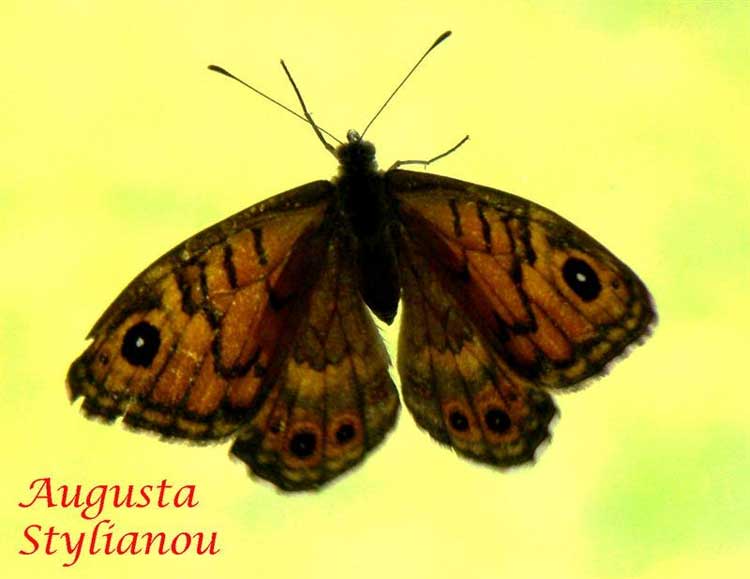
Lasiommata megera, Germasogeia (Yermasoyia), Cyprus, Photo: Augusta Stylianou Artist
Superregnum: Eukaryota
Cladus: Unikonta
Cladus: Opisthokonta
Cladus: Holozoa
Regnum: Animalia
Subregnum: Eumetazoa
Cladus: Bilateria
Cladus: Nephrozoa
Cladus: Protostomia
Cladus: Ecdysozoa
Cladus: Panarthropoda
Phylum: Arthropoda
Subphylum: Hexapoda
Classis: Insecta
Cladus: Dicondylia
Subclassis: Pterygota
Cladus: Metapterygota
Infraclassis: Neoptera
Cladus: Eumetabola
Cladus: Endopterygota
Superordo: Panorpida
Cladus: Amphiesmenoptera
Ordo: Lepidoptera
Subordo: Glossata
Cladus: Coelolepida
Cladus: Myoglossata
Cladus: Neolepidoptera
Infraordo: Heteroneura
Cladus: Eulepidoptera
Cladus: Ditrysia
Cladus: Apoditrysia
Cladus: Obtectomera
Superfamilia: Papilionoidea
Familia: Nymphalidae
Subfamilia: Satyrinae
Tribus: Satyrini
Subtribus: Parargina
Genus: Lasiommata
Species: Lasiommata megera
Subspecies: L. m. megera – L. m. transcaspica – L. m. usticae
Name
Lasiommata megera (Linnaeus, 1767)
Synonyms
Papilio megera Linnaeus, 1767 (original combination)
Lasiommata megera {Linnaeus):
Vernacular names
italiano: Megera
Lasiommata megera, the wall[1] or wall brown, is a butterfly in the family Nymphalidae (subfamily Satyrinae). It is widespread in the Palearctic realm with a large variety of habitats and number of generations a year.
Description
P. megera L. [— xiphie Boisd. pt (45d). Above reddish yellow, with a black mark which traverses the distal band from the cell of the forewing to the abdominal margin of the hindwing, short black stripes crossing the disc and the cell of the forewing.[2]
Range
The species lives in North Africa, Europe, the Caucasus, Asia Minor, the Middle East, western Siberia, northern Tian Shan, Dzungarian Alatau, Kazakhstan and Dzungaria.
Habitats
Habitats include forest edges and clearings, shrubby areas in ravines and river valleys and sparse woodlands. It is also found in mountain habitats up to 0–3,000 metres (0–9,843 ft) above sea level.
Egg, larva and pupa
Life history
The imago flies from April to October in two or three generations depending on locality and altitude. The larva feeds on grasses in the genera Festuca, Bromus, Deschampsia, Poa, Dactylis and Brachypodium.
"The egg is pale green when first laid, and in shape it is almost spherical, but rather higher than broad; it is finely ribbed and reticulated, but unless examined through a lens it appears to be quite smooth. The caterpillar when full grown is whitish-green, dotted with white. From the larger of these dots on the back arise greyish bristles; the three lines on the back (dorsal and sub-dorsal) are whitish, edged with dark green; the line on the sides (spiracular) is white, fringed with greyish hairs; anal points green, hairy, extreme tips white. Head larger than the first ring (first thoracic segment), green dotted with white and hairy, jaws marked with brownish. The chrysalis is green, with yellow-tinted white markings on the edge of the wing covers and ridges; the spots on the body are yellowish, or sometimes white. Occasionally the chrysalids are blackish, with white or yellow points on the body". (South 1906)
Subspecies
L. m. megera
L. m. vividissima
L. m. megerina (Herrich-Schäffer, 1856) – Transcaucasia
L. m. transcaspica (Staudinger, 1901) – Turkmenia
Size
Size: 36–50 millimetres (1.4–2.0 in)
References
Wall at UK Butterflies
Seitz. A. in Seitz, A. ed. Band 1: Abt. 1, Die Großschmetterlinge des palaearktischen Faunengebietes, Die palaearktischen Tagfalter, 1909, 379 Seiten, mit 89 kolorierten Tafeln (3470 Figuren)Public Domain This article incorporates text from this source, which is in the public domain.
"Lasiommata Westwood, 1841" at Markku Savela's Lepidoptera and Some Other Life Forms
butterfly-guide.co.uk
Retrieved from "http://en.wikipedia.org/"
All text is available under the terms of the GNU Free Documentation License

